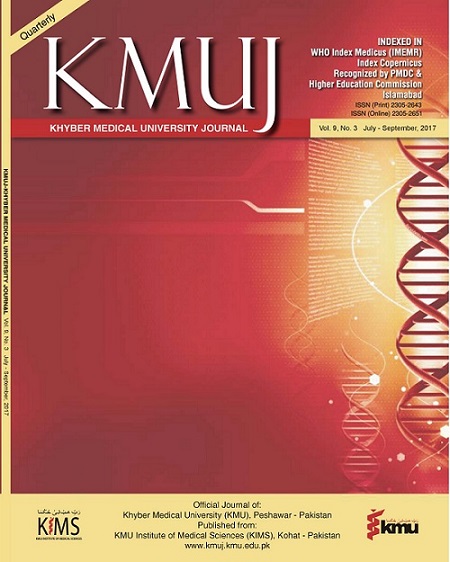ASSESSMENT OF PRESCRIPTION PATTERN AND PRESCRIPTION ERRORS USING THE WORLD HEALTH ORGANIZATION DRUG USE INDICATORS IN LADY READING HOSPITAL PESHAWAR, PAKISTAN: A RETROSPECTIVE STUDY
Main Article Content
Abstract
ABSTRACT
OBJECTIVES: To assess and evaluate prescription pattern and prescription errors using World Health Organization (WHO) drug use indicators in the medical ward of Leady Reading Hospital, Peshawar, Pakistan.
METHODS: This retrospective study of 200 in-patient’s prescriptions was conducted to investigate the WHO drug use indicators (average number of drugs prescribed per prescription, percentage of prescriptions encounter with an injection(s) prescribed, percentage of prescriptions encounter with an antibiotic(s) prescribed, percentage of drugs prescribed with generic names, percentage of drugs prescribed from the WHO’s Essential Drug List (EDL), drugs prescribed from the National Essential Drug List (NEDL) and prescriptions errors.
RESULTS: Drugs prescribed for 200 admitted patients were 1410 and average number of drugs prescribed per prescription were 7.05 (n=1410). Prescriptions with an injection(s) prescribed were 704/1410 (49.9%), prescriptions with an antibiotic(s) prescribed were 241/1410 (17.1%), prescriptions with drugs prescribed by generic names was none. Number of drugs prescribed from the WHO EDL were 704 (49.9%). NEDL was not available. A total of 572 (40.6%) errors in prescription writing were observed including 211/572 (36.9%) errors having absent strength of drugs, 267/572 (46.7%) contains an illegible hand writing prescriptions, 48(n=572; 8.4%) prescriptions have missing frequency of drugs and 46 (n=572; 8.04%) prescriptions had improper abbreviations. Decision errors were observed in 703 (n=1410;49.86%) cases for drug-drug interactions.
CONCLUSION: Illegible hand writing, absence of strength of drugs, no mentioning of frequency of drugs and improper abbreviations were main types of prescription errors while error in drug-drug interactions was the main decision error in our study.
KEY WORDS:Medical Errors (MeSH); Medication Errors (MeSH); Inappropriate Prescribing (MeSH); Prescription Errors (Non-MeSH); Prescription Pattern (Non-MeSH); Drug Use Indicators (Non-MeSH); Drug-Drug Interactions (Non-MeSH)
Article Details
Work published in KMUJ is licensed under a
Creative Commons Attribution 4.0 License
Authors are permitted and encouraged to post their work online (e.g., in institutional repositories or on their website) prior to and during the submission process, as it can lead to productive exchanges, as well as earlier and greater citation of published work.
(e.g., in institutional repositories or on their website) prior to and during the submission process, as it can lead to productive exchanges, as well as earlier and greater citation of published work.
References
REFERENCES
World Health Organization. The Rational Use of Drugs. Report of a conference of experts; 1985 Nov 25-29; Nairobi. Geneva: WHO; 1987.
Food, Medicine and Healthcare Administration and Control Authority (FMHACA) of Ethiopia. 2nd edition. Addis Ababa: Manual for Medicines Good Prescribing Practice; 2012.
World Health Organization. The use of Essential Drugs. 6th Report of the Expert Committee. Geneva: WHO Technical Report Series 850.3; 1995.
WHO. WHO Medicines Strategy: Framework for action Essential drugs and Medicines policy 2000-2003. Geneva: WHO; 2000. (WHO/EDM/2000.1).
Hogerzeil H, Sallami A, Walker GA, Fernando G. Impact of an essential drugs program on availability and rational use of drugs. Lancet 1989;333(8630):141-2.
World Health Organization. World Health Organization promoting rational use of medicines: core components. WHO Policy and Perspectives on medicine no. 5 Document WHO/ EDM/2002.3. Geneva: WHO; 2002.
World Health Organization. How to investigate drug use in health facilities (selected drug use indicators). Action programme on essential drugs. Geneva: WHO, 1993.
Silva AMS. In-patient medical prescription errors. Einstein 2009;7(3Pt1):290-4.
Barber ND, Dean BS. The incidence of medication errors and ways to reduce them. J Patient Saf Risk Manag 1998;4(4):103–6.
Cheraghali AM, Nikfar S, Behmanesh Y, Rahimi V, Habibipour F, Tirdad R, Asadi A, et al. Evaluation of availability, accessibility and prescribing pattern of medicines in the Islamic Republic of Iran. East Mediterr Health J 2004;10:406-15.
Das N, Khan AN, Badini ZA, Baloch H, Parkash J. Prescribing practices of consultants at Karachi, Pakistan. J Pak Med Assoc 2001; 5(2):74-7.
Isah AO, Ross-Degnan D, Quick J, Laing R, Mabadeje AF. The development of standard values for the WHO drug use prescribing indicators. International conference on improving use of medicines ICIUM/EDM/WHO. [Cited on December 26, 2016]. Available from URL: http://archives.who.int/prduc2004/rducd/ICIUM_Posters/1a2_txt.htm
Sapkota S, Pudasaini N, Singh C, Sagar GC. Drug prescribing pattern and prescription error in elderly: A retrospective study of inpatient record. Asian J Pharm Clin Res 2011;4(3):129-32.
Müller M. Polypharmacy, inappropriate prescribing and adverse drug reactions in Austria. Wien Klin Wochenschr 2008;120(23):713-4.
Hazra A, Tripathi SK, Alam MS. Prescribing dispensing activities at the health facilities of a non-government organization. Nat Med J India 2000;13(4):177-82.
Massele AY, Nsimbi SE, Rimoy G. Prescribing habits in church-owned primary health care facilities in Dar ES Salaam and other Tanzanian Coast regions. East Afr Med J 2001; 78(10): 510-4.
Lamichhane DC, Giri BR, Pathak OK, Panta OB, Shankar PR. Morbidity profile and prescribing patterns among outpatients in a teaching hospital in Western Nepal. McGill J Med 2006; 9(2):126-34.
Joshi MP, Sugimoto T, Santoso B. Geriatric Prescribing in the Medical Wards of a Teaching Hospital in Nepal. Pharmacoepidemiol Drug Saf 1997; 6(6):417-21.
Grasso BC, Genest R, Jordan CW, Bates DW. Use of chart and record reviews to detect medication errors in a state psychiatric hospital. Psychiatr Serv 2003;54(5):677-81.
